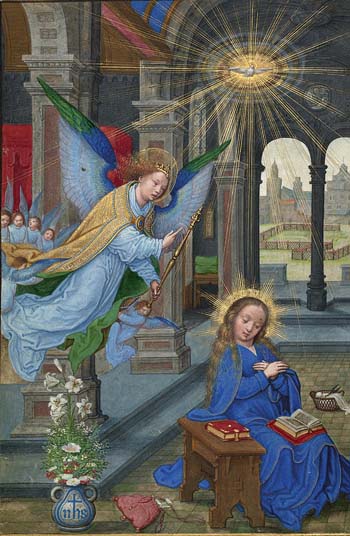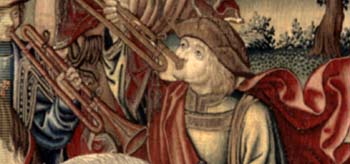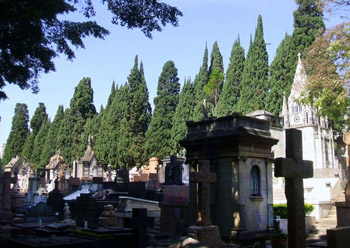Catholic Virtues
 |
 |
 |
 |
 |
 |
 |
True & False Paths to Happiness - XXXIV
The World of the Possibles
Since our universe is a model of the world of the possibles, the most spectacular thing to be found in it should give us an image of the pinnacle of the world of the possibles.
In terms of the union of the creature with God, the highest imaginable thing is the hypostatic union. Just below it is Our Lady's maternal virginity and the supplicating omnipotence of Our Lady.
The other day I read in a book by St. John Eudes something that – in this order of ideas – filled me with enthusiasm. Seldom has a reading left me so enthused, and I have spent the last few days inhaling the perfume of that enthusiasm.
 St. John Eudes recalls that in the beginning there were the Three Persons of the Holy Trinity, but not the human nature of Our Lord Jesus Christ.
St. John Eudes recalls that in the beginning there were the Three Persons of the Holy Trinity, but not the human nature of Our Lord Jesus Christ.
When Our Lady was in the Temple, moved by her ardent desire for the Messiah to come soon, she studied sacred writings to know how the Messiah would look and be. So imbued was she with the spirit of the Eternal Father that, even before the Messiah was born, She came to imagine what He would be like.
Therefore, before Our Lord Jesus Christ existed, she imagined Him. At the moment when, by her intelligence and love, she conceived that picture of how He should be, she had the desire to be the slave of the one chosen to be His Mother. It was then, at that moment, that the Archangel Gabriel appeared and invited her to be the Mother of our Savior.
St. John Eudes explains that thus she was the Mother of Our Lord Jesus Christ in a twofold way: first, she was His Mother because she conceived, by intelligence and love, how He should be; and second, because she begot Him.
The possibles in the symphony of the universe
The human soul was made to contemplate everything that is greater than itself, and even to have perceptions of the infinite. From this comes the feelings and vibrations one experiences when placed before all the possibles.
Thus can one imagine something that should be called “the universe of possible universes,” in which perfection would extend itself indefinitely, since the only limit for the possibles is the absurd.
Let us set out some of the innumerable possible universes.
The possibles in art & culture
I like the apparent contrasts that exist in a grandiose cathedral, where you see in a stained glass window God Himself playing with a child, as He did with the St. Herman Joseph, for example. This apparent contrast is very characteristic of the Middle Ages, that is, of the Church, which inspired that historical epoch.
 Often an artistic achievement is more a symbol of a possible than of something that exists. I consider this the pinnacle of civilization.
Often an artistic achievement is more a symbol of a possible than of something that exists. I consider this the pinnacle of civilization.
There is a scale where the first rung is the real world; the second is the archetype of the real; and on the third and highest step is the world of the possibles.
Neither poetry nor any other form of art has the gift to evoke the possibles like music. It evokes abstract beauties that are situated in an order of things that cannot really even define itself.
We hear, for example, a song that evokes battles in the world of the possibles. But this world of the possibles is not a chimera: In its own way, it has reality. The music I like best are those that speak most to my soul, that evokes the possibles. This is why the organ and the trumpet speak loudly to me, because they are instruments that remind me of the possibles. In my opinion, the harpsichord evokes more of the world of the possibles than the piano.
Music that does not cultivate the possibles is not music, it is just musical technique.
The possibles in History
When we imagine what Charlemagne's coronation could have been like, we perceive that the taste for History consists in savoring the possibles that could exist in it.
 I believe that the highest consideration that should be sought in History is not so much an explanation of events, but an evoking of the possibles which were realized in this or that episode and whose memory remained.
I believe that the highest consideration that should be sought in History is not so much an explanation of events, but an evoking of the possibles which were realized in this or that episode and whose memory remained.
This is what constitutes, for example, the charm of cemeteries with artistic tombs and mausoleums. You can feel the charm of old São Paulo, for example, at Consolation Cemetery.
It could be said that History confirms the phrase of Sacred Scripture that describes Wisdom who “was with him forming all things, and was delighted every day, playing before him at all times.” (Prov 8:30-31)
The possibles & nostalgic longings
These nostalgic longings are memories of a possible that has ceased to exist. So, when something has ceased to exist, it remains for us as a possible. And it remains in the world of the possibles surrounded by veneration and respect, like something that has passed away... There are a thousand literary, poetic, novelistic things – in the non-pejorative sense of the word – that settle there.
The person also perceives the possibles that are in himself. He can become inebriated, and what fantasies can be realized by the cognition of the internal possibles! On the other hand, how great a desire for sanctity, what a marvel of heroism or talent can be generated by each one's sense of what is possible for him to accomplish!
Woe to souls who do not have a sense of their inner possibles!
It can even be a form of entertainment to look at the faces in the street and ask whether or not the person has any notion of his internal possibles.
The possibles & the four elements
The four classical elements – earth, water, air and fire – also have their possibles. For example, the world of fire and flames obviously has its possibles, like the world of water. And what about the world of air? What man is not envious when he sees a bird fly? The delight of skydiving is much like swimming in the ocean, only it is an air bath.
The desire of man to know realities that are also in the world of the possibles serves as an inspiration for astronautical flights.
This realm of the world of the possibles constitutes a harmonious symphony that introduces us into the vestibule of Heaven!
Continued

The other day I read in a book by St. John Eudes something that – in this order of ideas – filled me with enthusiasm. Seldom has a reading left me so enthused, and I have spent the last few days inhaling the perfume of that enthusiasm.

At the moment Our Lady conceived the Savior in her mind, the Archangel appeared
When Our Lady was in the Temple, moved by her ardent desire for the Messiah to come soon, she studied sacred writings to know how the Messiah would look and be. So imbued was she with the spirit of the Eternal Father that, even before the Messiah was born, She came to imagine what He would be like.
Therefore, before Our Lord Jesus Christ existed, she imagined Him. At the moment when, by her intelligence and love, she conceived that picture of how He should be, she had the desire to be the slave of the one chosen to be His Mother. It was then, at that moment, that the Archangel Gabriel appeared and invited her to be the Mother of our Savior.
St. John Eudes explains that thus she was the Mother of Our Lord Jesus Christ in a twofold way: first, she was His Mother because she conceived, by intelligence and love, how He should be; and second, because she begot Him.
The possibles in the symphony of the universe
The human soul was made to contemplate everything that is greater than itself, and even to have perceptions of the infinite. From this comes the feelings and vibrations one experiences when placed before all the possibles.
Thus can one imagine something that should be called “the universe of possible universes,” in which perfection would extend itself indefinitely, since the only limit for the possibles is the absurd.
Let us set out some of the innumerable possible universes.
The possibles in art & culture
I like the apparent contrasts that exist in a grandiose cathedral, where you see in a stained glass window God Himself playing with a child, as He did with the St. Herman Joseph, for example. This apparent contrast is very characteristic of the Middle Ages, that is, of the Church, which inspired that historical epoch.

Trumpet calls which beckon men to battle
There is a scale where the first rung is the real world; the second is the archetype of the real; and on the third and highest step is the world of the possibles.
Neither poetry nor any other form of art has the gift to evoke the possibles like music. It evokes abstract beauties that are situated in an order of things that cannot really even define itself.
We hear, for example, a song that evokes battles in the world of the possibles. But this world of the possibles is not a chimera: In its own way, it has reality. The music I like best are those that speak most to my soul, that evokes the possibles. This is why the organ and the trumpet speak loudly to me, because they are instruments that remind me of the possibles. In my opinion, the harpsichord evokes more of the world of the possibles than the piano.
Music that does not cultivate the possibles is not music, it is just musical technique.
The possibles in History
When we imagine what Charlemagne's coronation could have been like, we perceive that the taste for History consists in savoring the possibles that could exist in it.

The charm of the possibles in Consolation Cemetery
This is what constitutes, for example, the charm of cemeteries with artistic tombs and mausoleums. You can feel the charm of old São Paulo, for example, at Consolation Cemetery.
It could be said that History confirms the phrase of Sacred Scripture that describes Wisdom who “was with him forming all things, and was delighted every day, playing before him at all times.” (Prov 8:30-31)
The possibles & nostalgic longings
These nostalgic longings are memories of a possible that has ceased to exist. So, when something has ceased to exist, it remains for us as a possible. And it remains in the world of the possibles surrounded by veneration and respect, like something that has passed away... There are a thousand literary, poetic, novelistic things – in the non-pejorative sense of the word – that settle there.
The person also perceives the possibles that are in himself. He can become inebriated, and what fantasies can be realized by the cognition of the internal possibles! On the other hand, how great a desire for sanctity, what a marvel of heroism or talent can be generated by each one's sense of what is possible for him to accomplish!
Woe to souls who do not have a sense of their inner possibles!
It can even be a form of entertainment to look at the faces in the street and ask whether or not the person has any notion of his internal possibles.
The possibles & the four elements
The four classical elements – earth, water, air and fire – also have their possibles. For example, the world of fire and flames obviously has its possibles, like the world of water. And what about the world of air? What man is not envious when he sees a bird fly? The delight of skydiving is much like swimming in the ocean, only it is an air bath.
The desire of man to know realities that are also in the world of the possibles serves as an inspiration for astronautical flights.
This realm of the world of the possibles constitutes a harmonious symphony that introduces us into the vestibule of Heaven!
Continued

Posted October 11, 2021





